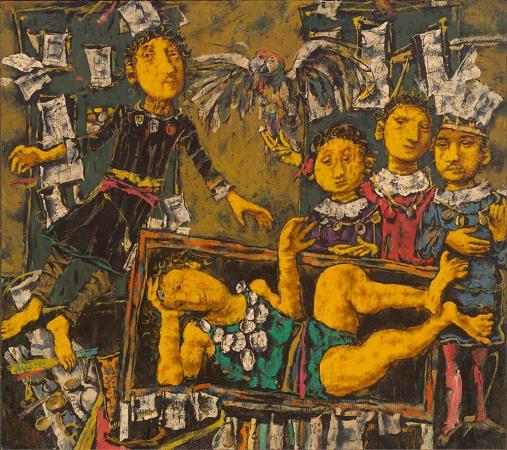Golem. A golem is an animated anthropomorphic being in Jewish folklore, which is created entirely from inanimate matter, usually clay or mud. In art, the golem is typically portrayed as an imposing figure often depicted with a crude, unfinished appearance to emphasize its raw, elemental nature. It is frequently illustrated with Hebrew inscriptions on its forehead or body, symbolizing the mystical words that bring it to life, and evoking its connection to Jewish mysticism and the divine. The golem's portrayal often reflects its dual nature as both protector and potential threat, capturing its role as a powerful but soulless creation that can spiral out of control, highlighting themes of creation, responsibility, and the dangers of unchecked power. The most famous golem narrative involves Judah Loew ben Bezalel, the late 16th-century rabbi of Prague. According to Moment magazine, the golem is a highly mutable metaphor with seemingly limitless symbolism. It can be a victim or villain, man or woman, or sometimes both. Over the centuries, it has been used to connote war, community, isolation, hope, and despair. In modern popular culture, the word has become generalized, and any crude anthropomorphic creature devised by a sorcerer may be termed a golem. There may be iron golems, such as Talos, or stone golems, e.g., in Dungeons and Dragons. The word golem occurs once in the Bible, in Psalm 139:16, which uses the word to connote the unfinished human being before God's eyes. The Mishnah uses the term to refer to someone who is unsophisticated: Seven characteristics are in an uncultivated person, and seven in a learned one. In Modern Hebrew, is used to mean dumb, helpless, or pupa. Similarly, it is often used today as a metaphor for a mindless lunk or other entity that serves a man under controlled conditions, but is hostile to him in other circumstances. Golem passed into Yiddish as, meaning someone who is lethargic or in a stupor. Earliest stories The oldest stories of golems date to early Judaism. In the Talmud, Adam is initially created as a golem when his dust is kneaded into a shapeless husk. Like Adam, all golems are created from mud by those close to divinity, but no anthropogenic golem is fully human. Early on, the main disability of the golem was its inability to speak. Sanhedrin 65b describes Rava creating a man, whom he then sends to Rav Zeira. Zeira speaks to the man, but he does not answer, whereupon Zeira says, You were created by the sages; return to your dust. During the Middle Ages, passages from the Sefer Yetzirah were studied as a means to create and animate a golem, although little in the writings of Jewish mysticism supports this belief.
more...


